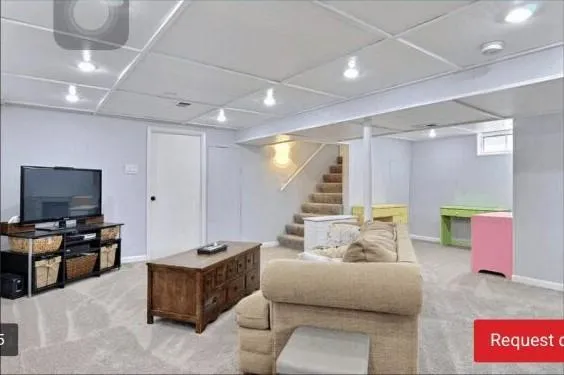
DIY Basement Remodel
When we first bought our starter home, we did so with the intention of remodeling the basement to extend our living quarters. Technically, it was already finished. It was counted in the square footage as a finished basement when we bought it.
But it hadn’t been updated since the house was built in the 60’s so when we came to own it in 2010, it was very outdated and very dark. I hated being down there.
We lived in that home for six years and it wasn’t until we were ready to sell that we were able to work on the basement. Which was such a shame as it was a huge space and would have doubled our living quarters. But time and money prevented us, unfortunately.
As you can imagine, when we were able to fix it up, it was exciting for our family, even if we were doing it for future homeowners. This DIY basement remodel is very basic but I wanted you to see what we did and hopefully give you a few tips for any spaces in your home that need sprucing up.
Some of the links in this post may be affiliate links, you can read my full disclosure here or look for more information at the bottom of this post.
DEMO
The first thing we did was tear down the ecru ceiling tiles. These were glued onto the rafters but were so old most came down without too much of a struggle. (It’s important to have proper eye and mouth protection for projects like this!)
Once the tile came down and was hauled away, we worked on the floor tile. This was the hardest part because these were also glued to the concrete and only some of it lifted easily. The rest took some serious effort. (Having a long-handled flooring scraper saved our backs and cut our time in half!)
Once all the demo trash was cleaned up, we went to work on the bones of our project.
CEILING
We were working on a tight budget since we were planning to move so we decided to keep the basement as open as possible. There was one section of the basement that had the sewer pipe, etc. clustered together so we framed that into a wall with an access panel. The rest was left open.
With the wall framed in, we went to work on the ceiling. We spent hours going over the most affordable options available to us and ultimately came across a unique idea on Pinterest. Instead of using ceiling tiles, we could use beadboard and frame it in. This was comparatively inexpensive and easy compared to our other options so I fell in love with the idea right away.
Steve took a bit more convincing but when I showed him some examples and the cost difference, he was willing to give it a try.
Don’t ask me how Steve was able to measure everything out because it was so technical due to the weirdness of our ceiling. Plus we added a ton of recessed lighting which meant more precise measurements and cuts. It was a headache, but I was so impressed that Steve only had to redo one board due to mismeasuring.
TRIM
After all the paneling went up, it was time to cut the 1-inch furring strips to trim out the paneling. (Let me add, if this was our forever home, we would have saved for nicer wood and rounded the edges. But, we were remodeling to sell, so we did the best with the money we had.)
While Steve worked on the trim, I wired all the lights and put them in.
The ceiling was time-consuming but so beautiful when it was all said and done. This is what it looked like all put up. It hasn’t been painted or covers put back on but I liked it so much better already.
Some people caulk the trim before painting but because we nailed them to the existing rafters and the boards were not all perfectly straight, it was too much work to caulk. With that said, I really liked the rustic look and preferred it to the caulked look, anyway.
PAINT
To tell you I spent a lifetime painting this basement (including the laundry room and bathroom) would be a gross understatement. I spent close to 40 hours prepping, taping, and painting just the main room and ceiling.
At one point, we had carpet coming at 8 am and I finished the last of the paint with four hours to spare. Afterward, I just had to do touch-up.
Before I go any further, I must tell you about my best friend, Behr Marquee paint. Of all the hundreds of hours I spent painting, I have yet to find a paint I love more.
It claims to cover in one coat and it does. This paint saved my sanity. I couldn’t even imagine adding a second coat and doubling my workload.
Plus, one gallon is equal in price to two gallons of the cheap stuff and since you have to do two coats of the cheap stuff, it evens out. When you are paying the same for one or the other, it’s a no-brainer to choose the option that offers less work. Two coats or one coat? Marquee, please!
Also, while looking for ways to save time and money, I read several times from other DIYers that you can, indeed, paint paneling without having to sand first. I decided to go with their advice and paint the paneling. I do not recommend it. Not if you plan to spend any time in your basement.
The paint chipped so easily. I was extremely disappointed but we could not do it over. (We did leave the new homeowners with a full gallon of my beloved Marquee in case they needed to touch anything up after moving in.)
CARPET & TILE
In case you were wondering what our tile used to look like, here it is. This was underneath a nasty green carpet that didn’t want to come up.
We didn’t want to carpet the landing since the back door is the one that leads in from the garage and is used most often. So we found some peel and stick floor panels that matched our color designs. I couldn’t believe the difference it made in that little space!
REVEAL
To recap our DIY basement remodel, all we did was demo the space down to its bare bones, add a new ceiling, a small wall, carpet, and paint the walls.
So this was what it looked like before:
And here are a few pics of the finished space:
These pictures were taken from the listing of our house but do a great job of showcasing the night and day difference this simple remodel gave to our home.
Two days after listing our home, we were inundated with showings and several offers above our asking price. It was crazy!
I believe it was the result of prayer, hard work, and an awesome listing photographer. 🙂
This shows that even if you are on a budget, you can have a new-to-you space with a little hard work and creativity.
And if you haven’t already, check out our other basement remodeling projects in the bathroom and laundry room:
*As an Amazon Associate, I earn from qualifying purchases, but if I am recommending an item in my post, it is only because I have used it myself or have done enough research on the product to feel it is a good fit for my readers.
© 2023 Freedomkit | Powered by Freedomkit.ai

